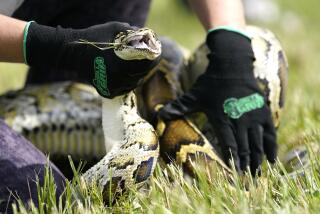Experts Call Chance of Attack Rare
- Share via
MIAMI — Hot, marshy and bristling with razor-edged saw grass, the Everglades present as forbidding a natural landscape as can be found in the United States. Indeed, this unique ecosystem is home to many thousands of alligators as well as poisonous water moccasins and pygmy rattlesnakes.
But despite the ominous presence of a police sharpshooter who rode the airboat Monday that shuttled searchers to the spot where ValuJet Flight 592 crashed, the chances of anyone in that area being bitten by a reptile are as remote as the location, according to scientists who work there.
“There are deer flies, which will bite and are annoying, but there aren’t even any mosquitoes in the saw grass,” said Ronald E. Hofstetter, a wetlands biologist who regularly leads his University of Miami students on wading trips into the area of Saturday’s crash.
Despite the fact that decaying bodies could attract predators, Hofstetter dismissed the notion that alligators or snakes are likely to be in an area where a jetliner came down--slicked-over with jet fuel and churning with airboat traffic.
“A bigger danger,” said Hofstetter, “would be fire ants along the levee” used as a staging area for the recovery effort. Fire ants, which are found everywhere in Florida, can give a painful bite.
What Florida Game and Fresh Water Fish Commission spokesman Jim Huffstodt called “some exaggerated reports of the threats by animals to rescuers” are just some of the confused and misleading rumors about the little-known Everglades that have circulated since the disaster.
*
The vast Everglades ecosystem, which includes the 1.4 million acres of Everglades National Park, is not a jungle. Rather, it is a marsh covered by herbaceous vegetation and a shallow layer of fresh water that moves slowly southward over the Florida peninsula.
The Everglades are home to a huge variety of wading birds, deer, turtles, rabbits and other animals, including alligators and snakes.
But close, unwanted, encounters are rare.
“We have officers and biologists in that area all that time and in the 10 years I’ve been here, no one has ever been bitten by an alligator or a snake,” Huffstodt said.
Scientists who study and regularly visit the Everglades also dismiss speculation that the bed of peat and black muck that seems to have swallowed the DC-9 could be anywhere near 40 or 50 feet deep, as has been reported.
“I don’t see anything anywhere in that area with soils that thick,” said Roy Sonenshein, hydrologist with the U.S. Geological Survey in Miami.
Both Sonenshein and Hofstetter said the average thickness of peat--decaying vegetation that eventually becomes muck--throughout the Everglades is 3 to 5 feet, with occasional pockets up to 12 feet where the underlying limestone rock is pitted.
How, then, did the aircraft disappear?
Although federal officials may get a clear answer to that question with sonar equipment being brought in by the U.S. Navy, the fuselage and most of the wreckage is probably covered with peat and muck, but near the surface, Hofstetter guesses.
*
“The plane might have impacted the peat, loosened it up and made it into a big bowl of mush, like a porridge,” said Hofstetter. “So if someone steps in those areas, it’s going to be deeper.”
Despite misinformation about the Everglades, recovery of the crash victims and airplane debris does present enormous problems and real hazards. There is little firm footing, temperatures are above 90 degrees and some native reptiles can be threatening.
But as federal officials pointed out in briefings Monday, no alligators or snakes have been spotted in the immediate vicinity of the crash site.
“Alligators will run away from you,” said Tony Zecca, chief of the Miccosukee Tribe’s 18-officer police department. “The only time they go for you is when you try to feed them. Even the moccasins tend to go the other way.”
“Of course,” he added, “the stories about animals are part of the whole mystique of the Everglades.”
Jet fuel which is still strongly in evidence in the area also would serve to keep away alligators, snakes and birds, including turkey vultures, which are also common, Hofstetter said.
As for the long-term environmental impact of the crash and fuel spill, Hofstetter said that there is likely to be none. “The 1972 crash [of an Eastern L-1011, in which 101 persons died] took place about three to five miles away, and there is no sign of it today,” he said.
More to Read
Sign up for Essential California
The most important California stories and recommendations in your inbox every morning.
You may occasionally receive promotional content from the Los Angeles Times.










